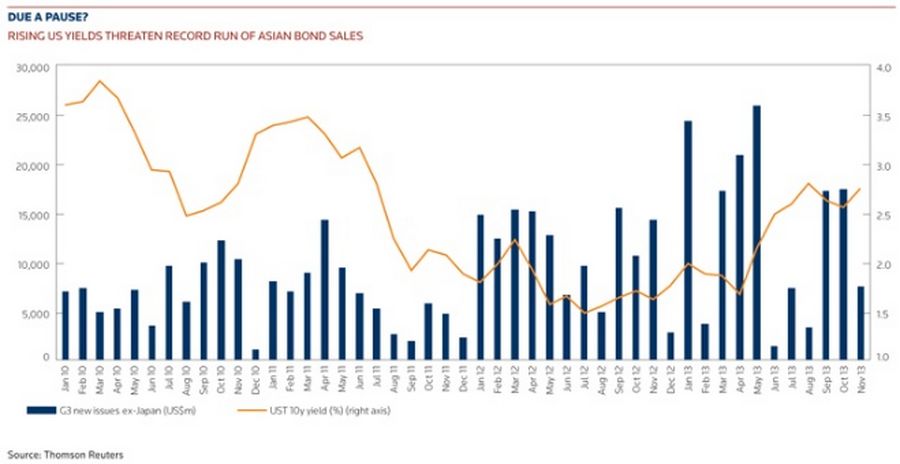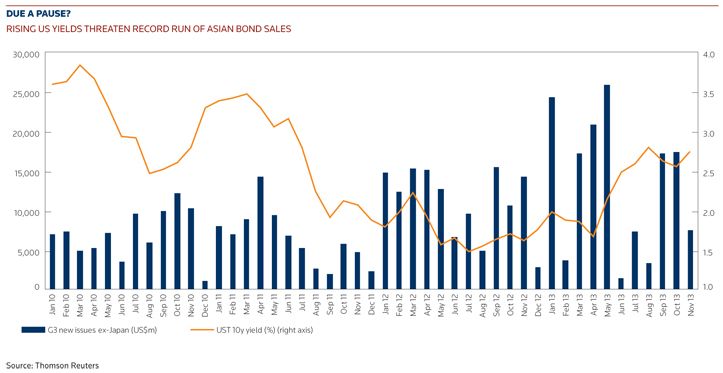Asia’s debt markets rocketed to a record in 2013. It was far from plain sailing, though, and investors’ reluctance to embrace some of the riskier issuers and structures means far greater difficulties are in store for 2014.
Low rates and unflagging investor appetite for most of the year pushed bond sales in Asia to an all-time record high. Sales of Asian debt in G3 currencies had already beaten last year’s US$133.8bn tally as of mid-November, with the total in IFR’s 12-month review period at an unprecedented US$146.5bn.
The banner year for Asia, excluding Japan and Australasia, is an unintended consequence of the US Federal Reserve’s monetary policies, which kept bond prices high and yields low throughout much of the world and sent investors scrambling to find yield in emerging markets.
That has been a dream come true for bankers and syndicate managers at debt capital market desks across the region.
Still, the bewildering array of securities issued in the sovereign, investment-grade and high-yield sectors has created a sense of vertigo in a region that, until the last two years, was used to far more modest activity.
The primary bond market for Asian G3 securities was about 40% smaller before 2012, making it much easier to notice landmark deals. The market now resembles an overcrowded room of individuals jostling for attention.

Last bond blowout?
Will it last? In May, the markets got a taste of how sensitive investors are to the Fed’s plans to scale back its monthly US$85bn purchases of US government and mortgage debt. Primary bond issuance came to halt and cash drained from emerging markets after Fed Chairman Ben Bernanke said the central bank would begin tapering the stimulus on further signs of improvement in the US economy.
Surprisingly, however, the “taper tantrum,” as it came to be called, did not last. Investors focused on economic fundamentals within emerging Asia and central banks in the region took action. Indonesia, for instance, raised rates 150bp before September. The markets regained their footing come mid-September, when cash began flowing back into the region.
“You could say that the May ‘taper tantrum’ was something of a defining moment for EM credit, more, perhaps, in terms of the recovery in sentiment that followed it, particularly in Asian credit,” said Jake Gearhart, head of debt syndicate at Deutsche Bank in Singapore.
“We’ve cleared some major crises in 2013 and, in a sense, we’re running out of crises. As far as Asian credit is concerned, it seems to me that it’s not just about ‘tourist money’, but it is firmly established as an asset class with long-term staying power,” Gearhart said.
The markets could go haywire again when the Fed actually does begin to scale back its bond purchases, but bankers seem to believe the US central bank’s forward guidance for short-term rates to remain near zero throughout 2014 will be enough to keep markets calm.
The elephant in the room is, perhaps, the behaviour of US Treasury yields. The 10-year Treasury yield rose to about 2.75% as the year drew to a close, up from 1.76% at the start of January. Earlier this year, any Treasury selloffs reversed when news of softer US economic data surfaced, keeping rates low. The consensus now, however, seems to be that US growth is sufficiently strong to usher in a period of secularly rising long-term yields, a scenario that could put the brakes on new issuance in Asia.
Starting with bang
The banner year began in January with a stunning US$24.2bn in debt sales from 53 deals, according to data from Thomson Reuters. Offering levels came back to earth in February, but about US$18bn was sold each month, on average from March until Bernanke’s comments in late May.
China oil major CNOOC managed to find a pure sweet spot for issuance in early May, when it priced a US$4bn, four-tranche, SEC-registered Global, the biggest conventional G3 bond out of Asia in a decade. The bond, the biggest in the G3 market from any Chinese issuer, and the third-largest on record in Asia, was 4x oversubscribed with a whopping US$23.8bn in orders, the most this year.
Soon after that blockbuster, debt sales slowed in June in the wake of the Fed’s comments, with only US$429m sold across two deals. However, sentiment picked up unexpectedly soon after as fears over Fed policies receded. Asian borrowers sold US$4bn in July and US$3bn in August before the floodgates opened with US$15bn issued in September and another US$14bn in October.
The year’s hallmarks
Syndicate bankers this year often considered their transactions to be well crafted if they attracted bids from private banks, servicing the burgeoning base of Asia’s high-net worth investors.
Yet, bonds with significant PB participation began to earn a reputation for trading badly in the secondary market, causing other investors to steer clear of deals thought to be attracting too many orders from these less-experienced investors. PB investors also gained a reputation for quickly selling off holdings if they did not perform well soon after pricing.
Shimao Property’s US$800m seven-year non-call four bonds in early January pulled in an eye-popping US$7bn of PB orders. That was in the context of a huge US$17.5bn order book involving more than 400 accounts.
The offering illustrated one of the limits of relying on PB investors, the holders of 33% of Shimao’s debt. That is because the bonds gained only marginally in secondary trading after the deal priced. In contrast, only 14% of Country Garden’s US$750m 10-year non-call five went to PB from an equally staggering US$18.4bn order book. Those bonds went up two points in secondary soon after pricing.
Investor concerns did not stop banks from offering PB investors incentive rebates of up to 50 cents per US$100 allocation throughout the year. The practice shows no sign of abating.
China’s homebuilders were ubiquitous throughout the year, as well, despite the ongoing debate over whether or not the nation was experiencing a property bubble. Country Garden and Kaisa were, in fact, the first to issue Asian debt in G3 currencies this year, edging out South Korea’s policy banks and the popular South-East Asian sovereigns, usually the first to offer bonds in the region.
The property developers also appeared to gain market credibility this year, although investor acceptance of two Triple C rated developers in January proved short lived. Hopson Development priced a US$300m five-year Reg S bond in early January, before Powerlong followed later in the month with a US$250m five-year non-call three Reg S paper. The fact the deals got done may have reflected some of the market enthusiasm gripping Asia at the start of the year.
Riskier bond investments did not have a good year overall. The most notable casualty was the perpetual format, where investors face the possibility of never recovering their principal.
The year did not start well for perps when KWG Property attracted little interest. When China’s Agile Property Holdings brought a perp later in January, the deal tanked three points in secondary trading soon after pricing. Investors found the fixed-for-life coupon on Agile’s bond provided little protection from the possibility of rising Treasury yields. Months later, in October, Aluminum Corporation of China, or Chalco, included a 500bp step-up at year five in its perpetual offering. Still, the price of Chalco’s securities fell soon after pricing, leaving questions about the perp as an investment option in Asia.
Mid-stream high-yield was buoyant in 2013, however, with 150% more volume over last year. China property companies dominated with issuance totalling US$8.3bn, but Indonesian property companies also offered US$716m. Even Vietnamese property conglomerate Vingroup sold a US$200m 4.5-year bond, the biggest issuance in the offshore public markets from a privately owned Vietnamese issuer.
South Korea remained a stalwart issuer, even if it was rather difficult to get excited about the string of policy bank and electricity-generating company deals that emerged. A standout was the Export-Import Bank of Korea’s “green bond”, which may herald the emergence of Asian primary debt to fund eco-friendly projects.
Perhaps, the biggest question that went unanswered in 2013 was how to price Basel III-compliant bank capital securities, which must either be written off or converted to equity if a regulator declares the issuing bank is no longer viable.
ICBC stumbled when it issued a Basel III-compliant bond in October, a 10-year non-call five-year piece, which will be written down to zero if ICBC is declared non-viable. China Citic Bank followed with a Basel III-compliant offering in early November that included a partial write-down feature. The format that China Citic used for its deal might turn out to be the only one the market accepts from Asia in this nascent, albeit strategically essential sector.
The Basel III securities were the only standout in terms of product development in Asia’s G3 market in 2013. In truth, 2013 was much like last year except the volume was bigger and deal count higher. While US and European accounts are more disposed to put in credit work on Asian names than in the past, it is hard not to think of this year as driven by the global quest for yield.
The question of whether Asian credit really came of age this year or was simply the target of yield-starved investors should be answered next year when US Treasuries finally begin their long-anticipated and sustained rise.
To see the digital version of this report, please click here.
